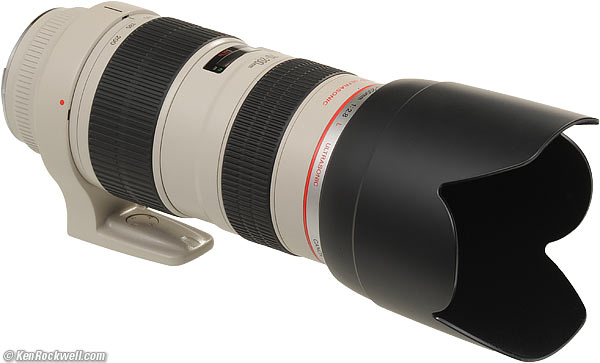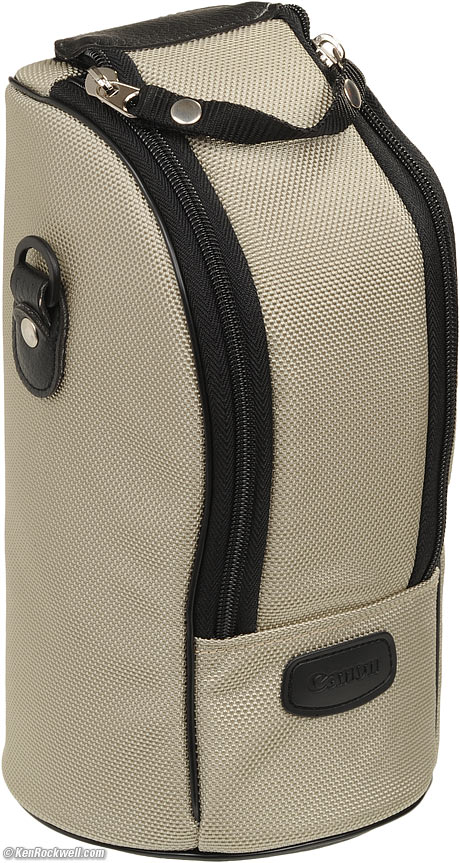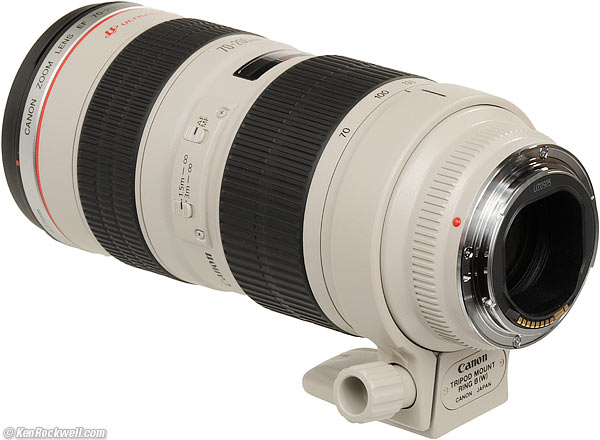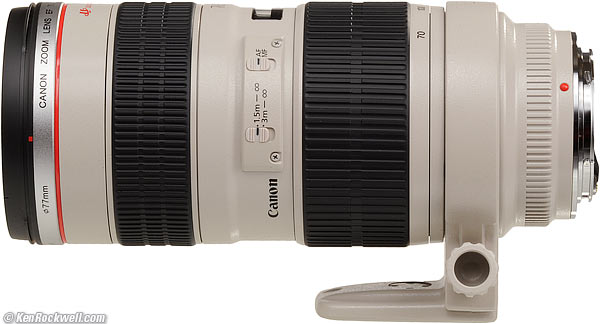Home Donate New Search Gallery Reviews How-To Books Links Workshops About Contact
Canon 70-200mm f2.8
Full-Frame EF L USM (1995-today)
© 2011 KenRockwell.com. All rights reserved.
Intro Specs Performance Compared Usage Recommendations
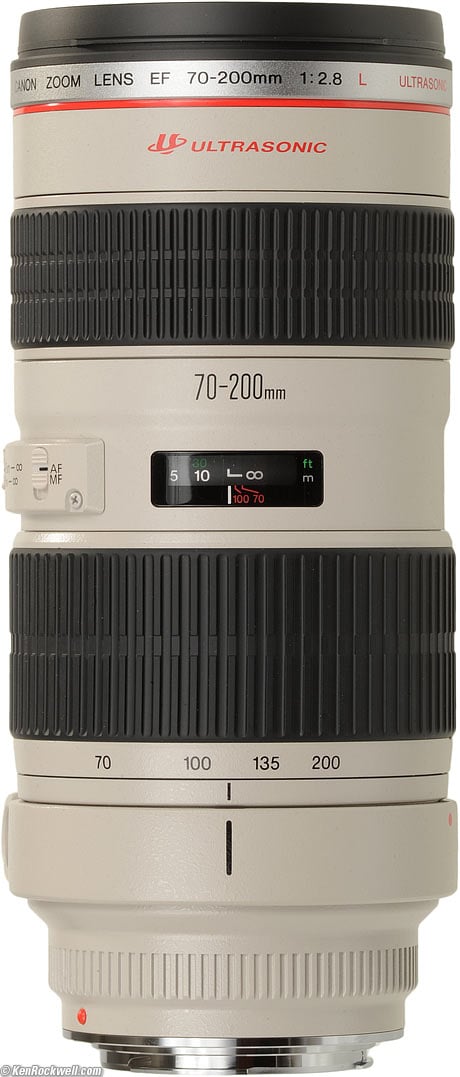
Canon EF 70-200mm f/2.8 L USM (covers all formats, 77mm filters, 5 feet/1.5m close-focus, 48.3 oz./1,370g with collar, 44.2 oz./1,253g without collar, about $1,375.) This free website's biggest source of support is when you use these links, especially these directly to it at Adorama or at Amazon, when you get anything, regardless of the country in which you live. Thanks! Ken.
November 2011 Canon Reviews Canon Lenses All Reviews
See also:
Canon 70-200 Comparison Table.
Canon 70-200mm f/2.8L IS II (2010-)
Canon 70-200mm f/2.8L IS (2001-2010)
Canon 80-200mm f/2.8L (1989-1995)
Canon 70-200mm f/4L IS (2006-)
Canon 70-200mm f/4L (1999-)
Introduction top
Intro Specs Performance Compared Usage Recommendations
The Canon EF 70-200mm f/2.8L USM is a fully professional 70-200mm f/2.8 zoom for half the price of the very similar Canon 70-200mm f/2.8 L IS II. The only benefits for paying twice as much for the flagship 70-200mm f/2.8 L IS II is Image Stabilization (IS) and slightly better optical and AF performance, so if you're shooting from a tripod, this 70-200/2.8 does the same thing for half the price, with a little less weight.
Just grab the focus ring at any time for instant manual-focus override.
This was Canon's top professional zoom from 1995 thorough 2001, when the first 70-200mm f/2.8 IS was introduced. This 70-200/2.8 (non-IS) remains in production because if you're shooting action or shooting from a tripod, IS doesn't do anything.
Just like with Canon's $2,400 Canon 70-200mm f/2.8 L IS II, Canon graciously throws in not only caps, but also the ET-83II hood and very nice LZ1324 zippered, padded case with this lens.
This 70-200/2.8 is ideal for sports, action and tripod use. For hand-held nature and landscape use in the field, I own the Canon 70-200mm f/4L IS which costs a little less and and weighs a lot less, with the same optical performance and adds IS, which lets me leave my tripod at home. This f/2.8 lens is for the tripod crowd, and those who want f/2.8 for action or throwing backgrounds further out of focus.
This Canon EF 70-200mm f/2.8L USM lens replaces Canon's first professional tele zoom for their EOS (autofocus) system, the EF 80-200mm f/2.8 L of 1989.
This 70-200 2.8 is a top-drawer professional lens, built like a tank with optics to match. The only reason it costs half as much as today's showy Canon 70-200mm f/2.8 L IS II is because Canon can get $2,400 for its flagship, while few people pay any attention to this long-time favorite, so Canon makes a lot less profit on this one. Canon has also long ago amortized its development cost, so with this lens, you're paying directly for quality instead of paying extra for fluff and marketing.
Canon EF 70-200mm f/2.8 L USM. enlarge.
Compatibility and Formats
This L lens is optimized for 35mm film and full-frame digital, and of course works on 1.3x and 1.6x Canon cameras.
This Canon EF EOS 70-200mm f/2.8L works perfectly with every Canon EOS camera ever made, meaning every Canon DSLR and every Canon autofocus EOS 35mm SLR made since 1987.
This means of course it works great on today's 5D Mark II and Canon 7D, but it works just as well on my original Canon EOS 620 from 1987!
As a full-frame lens, this works on all Canon SLRs, regardless of format. As a professional lens, I will be reviewing this lens on full-frame.
Specifications top
Intro Specs Performance Compared Usage Recommendations
Name
Canon calls this the CANON ZOOM LENS EF 70-200mm f/2.8L USM.
EF means "electronic focus," meaning that there is an autofocus motor in the lens itself. All Canon lenses since 1987 have been EF.
L only means as expensive as L; it means nothing technically.
USM means Ultra-Sonic Motor. This means autofocus is almost silent, and that you can grab the big focus ring for instant manual focus override at any time.
Optics top
18 elements in 15 groups.
4 elements of magic UD glass.
Internal focus and internal zoom; nothing moves externally as focused or zoomed.
Focal Length
70~200mm.
On 1.3x Canon cameras it will see angles-of-view similar to what a 90~260mm lens would see on a 35mm camera.
On 1.6x Canon cameras it will see angles-of-view similar to what a 115~320mm lens would see on a 35mm camera.
Angle of View (on 35mm and full-frame cameras)
34º ~ 12º diagonal.
19.5º ~ 7º vertical.
29º ~ 10º horizontal.
Close Focus top
5 feet (1.5m), specified, from the image plane.
Maximum Reproduction Ratio top
1:6.25.
Minimum Subject Field top
152 x 226mm on full-frame.
Teleconverters
This lens may be used with either of the Canon EF 1.4x II or Canon EF 2x II Teleconverters.
Diaphragm top
8 blades.
Stops down to f/32.
Octagonal at most apertures.
Hard Infinity Focus Stop? top
No.
You have to let the AF system focus for you at infinity.
Focus Scale top
Yes.
The ring turns from infinity to the closest focus distance in about 135.º
Depth-of-Field Scale top
No.
Infra-Red Focus Indices top
Yes, marks for 70mm and 100mm focal lengths.
Not specified, but probably for 800nm wavelength.
Filter Thread top
77mm.
Metal.
Does not move, ever.
Size top
Canon specifies 3.3" (84.6mm) diameter by 7.6" (193.6mm) long.
It doesn't change size as zoomed.
Weight top
48.310 oz. (1,369.6g), measured with collar.
44.205 oz. (1,253.2g), measured without tripod collar.
Canon specifies 45.9 oz. (1,310g).
Hood top
Canon EF 70-200mm f/2.8 L USM with included ET-83II hood. enlarge.
$45 plastic bayonet ET-83II, included.
Tripod Collar top
The rotating and locking tripod collar removes for hand-held use.
Case top
Canon LZ1324 case, included. enlarge.
$54 LZ1324 zippered, padded case, included.
It's nice: the dual zippers are connected, and if you pull them down, Velcro at the top keeps it closed.
It comes with a strap to thread through its two side attachments if you want to sling it around your shoulder.
Caps top
Standard 77mm ET-77U front, included.
Standard EOS cap rear.
Introduced top
March 1995.
Quality top
Made in Japan.
Price, USA top
$1,375, November 2011.
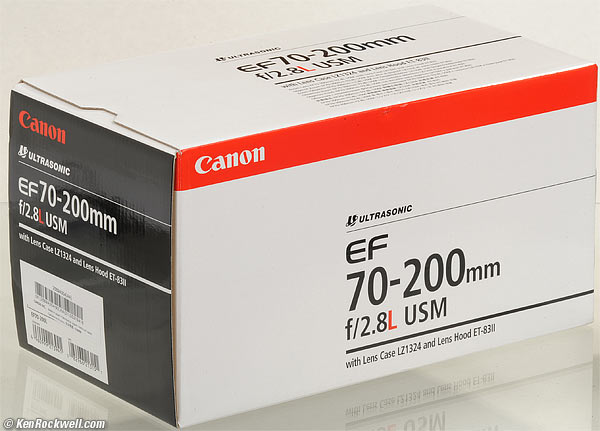
Box, Canon 70-200/2.8L USM.
Performance top
Intro Specs Performance Compared Usage Recommendations
Overall Autofocus Bokeh Breathing Color Distortion
Ergonomics Falloff Filters Flare and Ghosts Lateral Color Fringes
Overall performance top
The Canon 70-200mm f/2.8 L is optically and mechanically superb.
It's also big, heavy and expensive — but still only half the price of the very similar Canon 70-200mm f/2.8 L IS II, lacking only IS and a little bit of optical performance no one is likely to miss in exchange for the huge difference in price. Most of the price difference is because the Canon 70-200mm f/2.8 L IS II is the brand-new gotta-have-it lens, while this veteran pro lens has been in Canon's catalog unchanged for over 15 years.
Autofocus performance top
Autofocus is fast and silent.
It's as fast as the 70-200mm f/4 IS L, but a little slower than the Canon 70-200mm f/2.8 L IS II.
Auto/Manual Switching
Just grab the focus ring at any time for instant manual-focus override.
Only move the AF-MF switch to MF if you want to disable the camera from auto focusing.
AF Speed
AF is fast, as Canons always are.
The AF motor is silent. All you'll hear is some internal sliding.
AF Accuracy and Consistency
I saw no autofocus error on my Canon 5D Mark II.
Especially at f/2.8, all my shots are dead-on perfect at every focal length.
Yes!
Manual Focus
Manual focus is easy; just grab the ring at any time.
It takes 135º to go from end-to-end of the focus scale.
Bokeh performance top
Bokeh, the quality of out-of-focus areas as opposed to the degree of defocus, is great wide-open at 200mm, becoming neutral as stopped down.
At 70mm it's mediocre wide open and neutral stopped down, but if you're worrying about soft backgrounds, you're shooting at 200mm anyway.
Here is are some full-frame shots at 200mm focused on a vertically-polarized phase lattice at 3 meters, with synthetic reference vegetation at 15 meters:
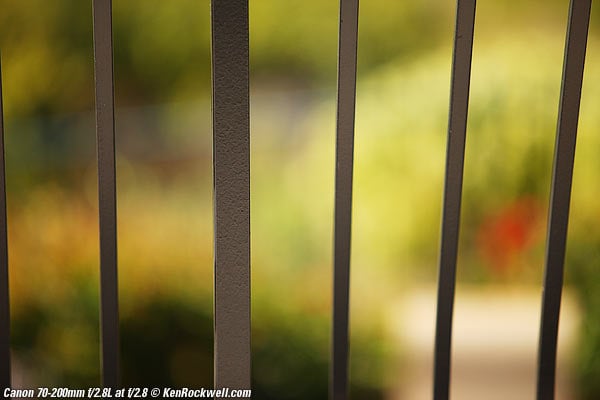
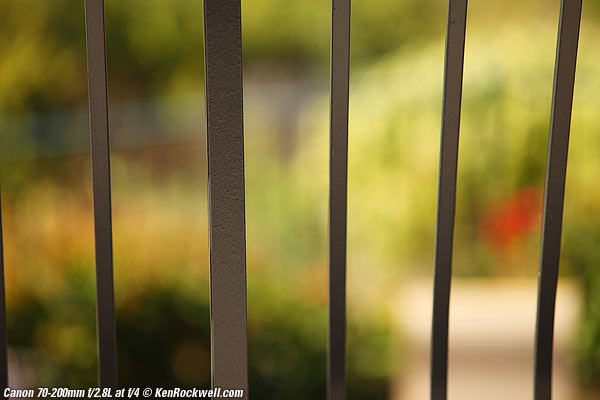
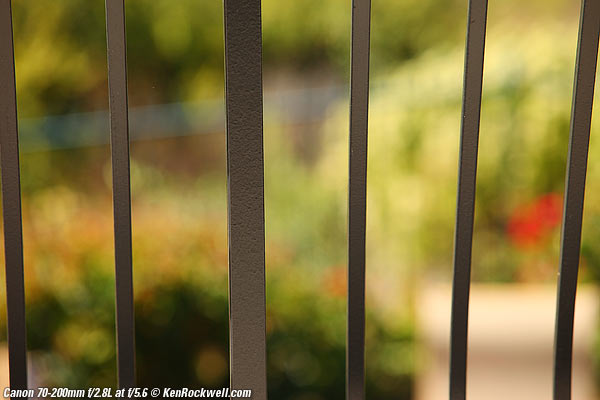
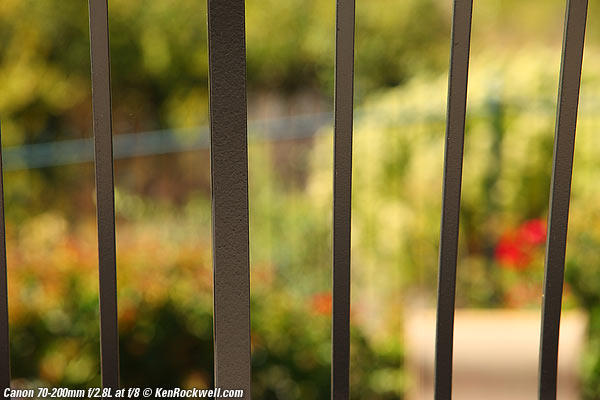
Focus Breathing performance top
Focus breathing (the image changing size as focused) is mostly of interest to cinematographers who don't want the image changing size ("breathing") as the lens is focused among different subjects.
The image from this Canon 70-200mm f/2.8 L always gets larger as focused more closely.
Color Rendition performance top
The color balance of this 70-200mm f/2.8 L seems to match my other Canon EF lenses.
Distortion performance top
The Canon 70-200mm f/2.8 USM has the usual distortion seen in telephoto zooms: It's got some barrel distortion at 70mm and some pincushion distortion at 200mm. The Canon 70-200mm f/2.8 L IS II has 25% less distortion, not that big a deal.
For critical use, use these values in Photoshop's Lens Distortion tool to remove it:
3m (10') |
infinity |
|
70mm |
+2.0 |
+3.2 |
100mm |
0.0 |
0.0 |
135mm |
-1.2 |
-1.0 |
200mm |
-2.0 |
-1.8 |
© 2011 KenRockwell.com. All rights reserved.
Ergonomics performance top
This is a big, fat, heavy lens.
The tripod collar is easily removable.
The focus ring is well damped and super-smooth. It's easy to move it with a fingertip, but due to its damping, won't ever move that fast manually.
The zoom ring can be moved with one fingertip, but it takes some effort. It works better with two fingers or your whole hand. The zoom feels as if it's working through a geartrain!
Falloff (darkened corners) performance top
Falloff is never a problem, although like most tele zooms, if you look too closely at blank sky shots, you'll see a little bit at 200mm.
My Canon 5D Mark II (as of firmware 2.0.4) doesn't have the data to correct this automatically in its Peripheral Illumination Correction menu option. If you go find the data and load it into your camera (I'm too lazy), it should correct for this automatically.
I've greatly exaggerated this by shooting a flat gray target and presenting it against a gray background:
Canon 70-200mm f/2.8 falloff on full-frame No peripheral illumination control
© 2011 KenRockwell.com. All rights reserved.
|
Filters, Use with performance top
Filters are easy.
The sturdy and precise metal threads don't move, and there isn't any problem with vignetting. Feel free to use thick rotating filters. There is no need for expensive "thin" polarizers.
Flare and Ghosts performance top
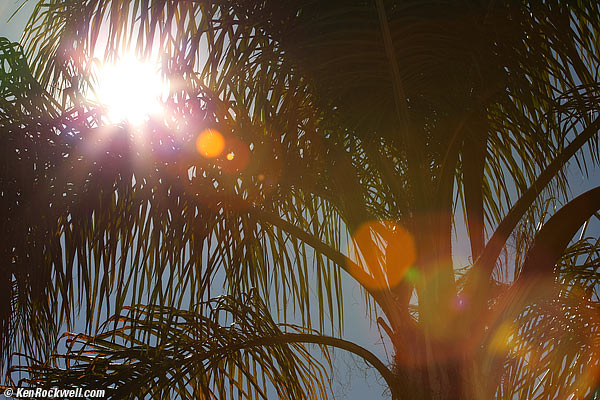
Flare and Ghosts at 100mm at f/8.
Flare and ghost performance is nothing out of the ordinary. You won't see any under normal use, and if you try to blind yourself looking at the sun, you'll be able to excite some.
In this shot, I'm looking directly at the sun. In actual use, no one would be this stupid and wound have the sun partially hidden behind the tree and not have this much flare. In this special case, I deliberately placed the sun to be unobscured by the tree, and then overexposed and had the tree in the picture precisely where I could see some ghosts. You won't see this unless you deliberately plan things this way to show them.
Lateral Color Fringes performance top
The usual curse of Canon, there are some green-magenta lateral secondary color fringes visible at the ends of the zoom range. Unlike with Nikon cameras, Canon cameras as of this writing (November 2011) have no ability to correct for this lens limitation.
As seen on my Canon 5D Mark II:
At infinity
Some green-magenta fringes at 70mm.
None at 100mm.
None at 135mm.
Very slight magenta-green fringes at 200mm.
At 3 meters (10 feet)
Some green-magenta fringes at 70mm.
Slight green-magenta fringes at 100mm.
None at 135mm.
Slight magenta-green fringes at 200mm.
Mechanics performance top
Rear, Canon 70-200 f/2.8 L. enlarge.
The Canon 70-200mm f/2.8 L is made to Canon's top professional standards, exactly like their 70-200mm f/2.8L IS II.
It's quite different from Canon's usual plastic lenses in the under-$2,000 bargain bin. This beast feels more like it comes from Canon's professional TV camera lens division: it's almost all metal and built like a tank.
Filter Threads
Metal.
Hood Mount
Metal.
Identity Ring
Metal.
Fore Barrel
Plastic.
Focus Ring
Metal, rubber-covered.
Mid-barrel
Plastic.
Internals
Seem like metal.
Zoom Ring
Metal, rubber-covered.
Rear barrel
Metal.
Moisture seal at mount
No.
Mount
Chromed metal.
Markings
Paint.
Serial Number
Engraved into bottom of lens barrel and filled with black paint.
Date Code
Yes, printed on the rear light shield.
See Canon Date Codes to find your lens' birthday.
This sample is marked UZ0925, meaning September 2011.
Noises When Shaken
Some clunking.
Made in
Japan.
Sharpness performance top
As shot on the 5D Mark II under test conditions at infinity, the Canon 70-200mm f/2.8 L is as sharp as the 70-200/4L IS, but not quite as sharp as the world's best 70-200mm f/2.8L IS II.
At 70mm, it's a little softer at f/2.8 in the center, and softer in the corners, sharpening up in the center by f/4 and by f/8 in the corners.
At 100mm, it's a very little bit softer at f/2.8 in the center, and softer in the corners, sharpening up in the center by f/4 and by f/5.6 in the corners.
At 135mm, it's a very little bit softer at f/2.8 in the center, and softer in the corners, sharpening up in the center and corners by f/4.
At 200mm, it's a very little bit softer at f/2.8 in the center, and softer in the corners, sharpening up in the center and corners by f/4.
Here are Canon's claimed MTF curves, which agree with what I see:
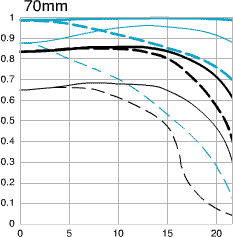

Canon's MTF Curves.
Sunstars performance top

Sunstars at 100mm at f/8.
With its 8-blade diaphragm, this Canon 70-200mm f/2.8L makes boring Canon-standard 8-pointed sunstars on brilliant points of light.
Compared top
Intro Specs Performance Compared Usage Recommendations
See my Canon 70-200 Comparison Table.
Mechanically, this original 70-200/2.8 is built as well as the newest Canon 70-200mm f/2.8L IS II.
Optically, this lens is about the same as the 70-200mm f/4L IS, which is excellent, but not as over-the-top perfect as the 70-200mm f/2.8L IS II. In each performance aspect, this non-IS lens is almost, but not quite as good as the 70-200mm f/2.8L IS II. Most people would never notice, so if money matters, get this original non-IS lens. If you need the best regardless of cost, pay twice as much for the 70-200mm f/2.8L IS II, which also gets you slightly faster autofocus and Image Stabilization.
See also Is It Worth It.
Usage top
Intro Specs Performance Compared Usage Recommendations
Canon 70-200/2.8L. bigger.
AF - MF Switch
Leave this in AF. Just grab the focus ring at any time for instant manual-focus override.
Only set it to MF if you want it to be locked into manual focus. In MF, it disables autofocus.
Focus Limiter
Leave it in the "1.5m ~ ∞" position.
The "3m ~ ∞" position prevents the lens from focusing any closer than 3 meters (10 feet). You might use this if you're shooting action at a distance and the lens is wasting time trying to focus this close and back looking for things.
Tripod Collar
Use this also for use on a monopod.
To remove, loosen the collar's knob, rotate the collar, and pull it off towards the rear of the lens.
Recommendations top
Intro Specs Performance Compared Usage Recommendations
The Canon 70-200mm f/2.8L is a top professional lens, with optics and mechanics designed for a lifetime of heavy service while delivering top optical performance.
It's a bargain today because it's been in Canon's catalog since 1995, not because it's any less well made than Canon's newest Canon 70-200mm f/2.8L IS II.
This original non-IS 70-200 is a sleeper of a lens. It's the lens to get for anyone on a budget shooting sports and action, or shooting on a tripod.
Personally, I shoot without a tripod in the field, having to carry this all day and night, so I own the Canon 70-200mm f/4L IS.
Seeing how Amazon's customer reviews are also nearly 100% 5-stars for this 70-200 2.8, it's not just me who loves this lens. Everyone does!
If you've found the time I've spent sharing this professional review helpful, this free website's biggest source of support is when you use these links, especially these directly to it at Adorama or at Amazon, when you get anything, regardless of the country in which you live. Thanks! Ken.
Thanks!
Ken.
More Information:
Canon's 70-200/2.8L Instruction Manual.
Help me help you top
I support my growing family through this website, as crazy as it might seem.
The biggest help is when you use any of these links to Adorama, Amazon, eBay, Ritz, Calumet, J&R and ScanCafe when you get anything, regardless of the country in which you live. It costs you nothing, and is this site's, and thus my family's, biggest source of support. These places have the best prices and service, which is why I've used them since before this website existed. I recommend them all personally.
If you find this page as helpful as a book you might have had to buy or a workshop you may have had to take, feel free to help me continue helping everyone.
If you've gotten your gear through one of my links or helped otherwise, you're family. It's great people like you who allow me to keep adding to this site full-time. Thanks!
If you haven't helped yet, please do, and consider helping me with a gift of $5.00.
As this page is copyrighted and formally registered, it is unlawful to make copies, especially in the form of printouts for personal use. If you wish to make a printout for personal use, you are granted one-time permission only if you PayPal me $5.00 per printout or part thereof. Thank you!
Thanks for reading!
Mr. & Mrs. Ken Rockwell, Ryan and Katie.
Home Donate New Search Gallery Reviews How-To Books Links Workshops About Contact





